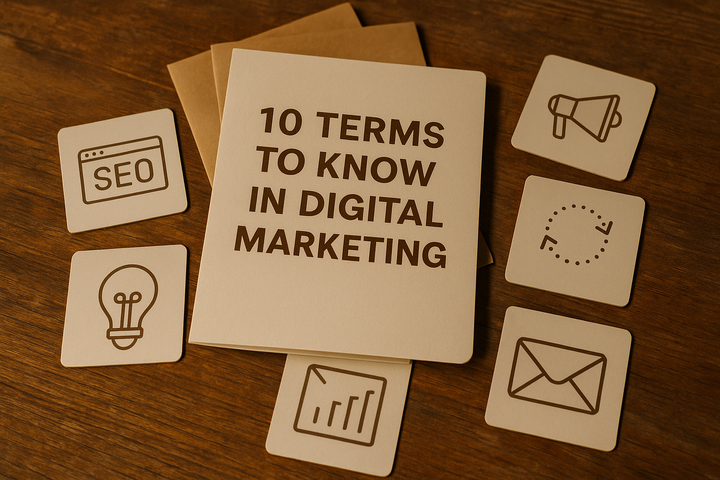What Does a Digit al Marketer Actually Do? Behind the Job Title
A digital marketer combines creativity, strategy, and analytics, executing campaigns while adapting to new trends and insights.

When I tell people I’m a digital marketer, I often get puzzled looks. Some assume my job is just posting on social media all day. In reality, social media is only one piece of a much larger strategy. It is just one channel among many. So what does a digital marketer do, really? In this firsthand look behind the job title, I’ll share how this role mixes creativity, strategy, and analytics on a daily basis.
Mapping the Strategy
Every successful digital campaign begins with strategy. Before I launch any ads or posts, I spend time researching and mapping out a game plan. This often means digging into data to understand our target audience. I consider who they are, what they need, and where they spend time online. For example, I might review customer surveys or analyze past website analytics to spot trends. A digital marketer will even study competitors’ moves and broader market trends to figure out the best ways to reach people. All this research feeds into a clear plan of attack.
Once the research is done, I set clear goals for what we want to achieve. This could be increasing website traffic, boosting online sales, or growing our email subscriber list. I’ll outline key performance indicators (KPIs) for each goal (metrics like conversion rates or social media engagement) so we have a way to measure success.
For instance, if the goal is lead generation, I define how many signups we aim for in a month. Setting these targets upfront ensures that every marketing effort ties back to a business objective. In other words, a digital marketer’s strategy isn’t just about making noise online; it’s about hitting real outcomes that matter to the company.
Mapping strategy can feel like being part detective and part architect. I’m sifting through clues about customer behavior and then blueprinting a plan to reach them effectively. For example, I once found through research that our audience cared more about ease of use than price, which led me to pivot the campaign messaging entirely to highlight simplicity over discounts. At this stage, I also chart out how we’ll achieve those goals. Based on our research insights, I decide which digital channels and tactics to prioritize. For example, if the data shows our audience is most active on Instagram, I’ll plan a social campaign there; if we’re targeting professionals, I may focus on LinkedIn and blog content. I often create a brief or content strategy document that outlines the messaging themes and content we’ll produce to meet our objectives. This strategy roadmap guides all the work that comes next. And before anything goes live, I make sure the plan aligns with our team and management, so everyone agrees on the direction.
Creating Campaigns
This is where ideas turn into actual marketing content out in the wild. Execution is the practical, creative part of the job, and it’s often the most hectic part. On any given day, I might be writing a blog post in the morning, designing a set of social media graphics by noon, and launching an email newsletter by the afternoon. In other words, a digital marketer switches gears constantly to bring the strategy to life. It requires a mix of creativity and sharp project management to keep all the moving pieces on track.
A huge portion of execution is content creation. This can mean drafting articles, writing catchy ad copy, filming a quick product video, or even brainstorming the next viral tweet. Many digital marketers create a variety of content types, such as blog posts, short videos, infographics, you name it, to engage their audience. For everything I create, I keep the brand’s voice and the audience’s needs in mind. For example, if I’m writing a post for a tech brand, I’ll ensure the tone is friendly but knowledgeable, and that it addresses a real pain point of our customers. Attention to detail is key here. I’m double checking spelling, making sure the visuals look professional, and confirming that all links and buttons work. It’s creative work but also meticulous.
Executing campaigns also means diving into the technical side of platforms. I might be in Facebook’s Ads Manager setting up a targeted ad campaign, choosing demographics and budgets. At the same time, I could be scheduling a week’s worth of Instagram posts and answering a few comments on yesterday’s post. If we’re running a Google Ads search campaign, I’ll write the ad copy and select keywords, then monitor it throughout the day. In between, I could be sending out an email blast using marketing software and making sure it goes to the right audience segment. It’s a lot of multitasking. But I’ve learned to embrace the chaos and use tools (like social media schedulers and email automation) to handle repetitive tasks so I can focus more on creativity.
Not every part of execution is glamorous. I’ve spent afternoons resizing ad images over and over or tweaking a landing page layout with a developer to get it just right. Still, when I finally hit "Publish" or see a campaign go live, it’s incredibly satisfying. Watching an ad I built show up in someone’s feed or seeing readers share an article I wrote makes all the scrambling worth it.
Multichannel Mastery
Digital marketing isn’t just one skill. It’s a blend of many different online specialties. On any given day, I find myself jumping between several platforms and tools. For context, a digital marketer might handle content on the website, social media pages, search engine visibility, email campaigns, and paid advertising all within the same role. In a large company, there may be separate specialists for SEO, email, or social media, but as a solo digital marketer (which I’ve been), you wear all those hats at once. That variety is exciting and challenging at the same time.
- Search Engine Optimization (SEO): Improving the company’s website content so that it ranks higher on Google and other search engines. I often tweak blog posts or product pages to include relevant keywords and ensure the site loads fast and works on mobile. Better SEO means more people find us when they search.
- Content Marketing: Creating useful, engaging content (like blog articles, guides, or videos) that attracts and educates our audience. This content not only helps with SEO but also gives us material to share on social and email. It’s about building trust by providing value, not just pushing sales.
- Social Media: Managing the brand’s presence on platforms like Facebook, Instagram, X (formerly Twitter), LinkedIn, and more. This involves posting updates, sharing content, and actively engaging with followers. I respond to comments and messages and keep the social profiles active and on message with our brand.
- Email Marketing: Writing and sending email campaigns to subscribers. Emails might include newsletters, promotional offers, or updates. I segment the audience (for example, separating existing customers from new sign ups) and tailor messages accordingly. The goal is to nurture leads and keep our audience informed.
- Paid Advertising (PPC): Running paid campaigns such as Google Ads or social media ads. This requires creating ad copy and visuals, choosing targeting criteria, and setting budgets. I continuously monitor and adjust these ads to make sure we get good results without overspending.
The key is that all these channels work together. A great campaign uses a mix of platforms in harmony. For example, we might use social media to drive traffic to a blog post, then use an email newsletter to follow up with people who saw that content. Effective digital marketing is about integrating multiple channels to build a cohesive presence for the brand. By being fluent in many platforms, a digital marketer ensures the message reaches people wherever they are online.
Analyzing and Adapting
After executing a campaign, the work isn’t over. It’s time to crunch the numbers. In fact, I probably spend as much time analyzing results as I do creating content. Every morning, I’m checking metrics: website traffic, social media likes, email open rates, sales conversions, and more. These numbers are the pulse of our marketing efforts. For example, I’ll track key performance indicators like how many people clicked on our latest email or how many impressions our Facebook ad earned. If a metric is below expectations, that’s a signal for me to dig in and figure out why.
Data doesn’t lie, and it often tells me exactly what’s working or not. I might discover that one ad isn’t getting any clicks, so I’ll quickly tweak the headline or target a different audience. Or I might see our website traffic spike after a blog post, telling me that topic really resonated. Being a digital marketer means constantly adjusting. I run A/B tests (for example, sending two versions of an email subject line to see which gets more opens) and use the winner going forward. After each campaign or content piece, I analyze what worked and what didn’t. Then I refine our approach. This iterative cycle of testing and tweaking is how we improve results over time.
Another crucial part of this phase is reporting. All those insights I gather need to be communicated to the team, managers, or clients in a clear way. I often compile a weekly or monthly report that sums up key results: how many leads we got, how much sales grew, which campaigns performed best. This can involve making charts or slides, but the real challenge is telling the story behind the data. I translate the numbers into plain English – for instance, explaining that "our Instagram campaign brought 500 new visitors to the site, which resulted in 50 purchases" instead of just saying "we had 500 visitors." By doing this, I help everyone understand what the marketing data actually means for the business. If something underperformed, I’ll highlight it honestly and outline a plan to improve. This transparency helps build trust and shows that decisions are based on evidence, not guesswork.
Ultimately, being data driven is what makes digital marketing a cycle of continuous improvement. I’ve learned that by trusting the data and being willing to adapt, our campaigns keep getting better. It’s gratifying to see the proof in the numbers when a tweak boosts our conversion rate or when a report shows we exceeded our goals. And even when the data isn’t great, it’s okay; it’s just feedback to guide our next move. In this way, analysis and reporting don’t just measure success – they actively drive the next strategy.
Teamwork and Communication
Digital marketing isn’t a solo endeavor. I work with many people to get campaigns from idea to reality. In fact, a surprising amount of my day is spent communicating and coordinating with others rather than just sitting at my desk creating. I might be in meetings with the sales team, customer service reps, or product managers to make sure our marketing aligns with what the business needs and what customers are saying. Marketing touches every part of a business, so I often act as a link between different departments.
For example, if we’re preparing to launch a new product feature, I’ll sit down with the product team to understand its details and unique benefits. That way, the blog post or social media announcement I create will be accurate and compelling. I also rely on our graphic designer’s expertise to produce visuals. I might sketch an idea, but they turn it into a polished graphic or video. If our campaign involves a special landing page on the website, I collaborate with a web developer to get it built and make sure it’s easy to use. These collaborations ensure that the marketing materials are high quality and technically sound. I’ve learned that a digital marketer has to speak a little bit of everyone’s language: design, tech, product, and sales.
Communication isn’t just internal. I also represent the marketing voice externally. On social media, for instance, I’m the one replying to user comments or addressing customer questions that come in via Facebook or Instagram. I have to be professional and empathetic, making sure each person feels heard while also reinforcing our brand’s message. This can mean coordinating with customer support on how to answer a tricky question from a user, or quickly alerting the PR team if I see a potential issue gaining traction online. In those moments, being a digital marketer means being the eyes and ears of the brand on the internet.
All these interactions require strong communication skills. I often need to explain marketing concepts to people who aren’t marketers, like why a campaign needs more time to gain traction or what terms like "engagement rate" mean. Being able to translate jargon and data into everyday language is a big part of my job. It takes patience and clarity, especially when stakeholders are skeptical or simply unfamiliar with digital marketing. At the same time, I have to listen. Colleagues in sales or support have valuable insights into customer needs, and by listening to them I can adjust our marketing to hit the right notes. In the end, teamwork makes our marketing efforts much stronger. When everyone is on the same page, our campaigns not only run smoother but also resonate better with the audience.
No Typical Day
I’ll be honest, this job keeps you on your toes. I quickly realized there’s no such thing as a “typical” day for a digital marketer. One day I might be focused quietly on planning and content, and the next day I’m scrambling because a trending meme popped up or Google changed its search algorithm without warning. The variety is constant, which means you have to be adaptable and ready for anything.
Staying up to date is probably one of the hardest parts of being in this field. Digital marketing techniques and tools evolve at breakneck speed. It often feels like no other industry changes as quickly. There’s always a new social media feature, an update to the Facebook algorithm, or a fresh SEO best practice to learn. To keep up, I regularly read blogs and listen to what industry experts are saying. This constant learning can be tiring, but it’s also what keeps the job interesting. You are never done learning, and that growth mindset is a must in digital marketing.
There are also plenty of misconceptions about this job that I’ve had to push against. Some people think digital marketing is instant magic. I’ve been asked, “Can you make this go viral by tomorrow?” many times. The reality is that success usually takes time and patience. Yes, occasionally an ad or post will catch fire overnight, but most of the time I’m playing a long game, building up brand awareness and trust step by step. I’ve also encountered the attitude that “anyone can do social media.” That underestimates the strategic thinking and analysis involved. No sugar coating here: it can be frustrating when others don’t understand the effort behind the scenes. I’ve learned to educate and set realistic expectations to counter this.
Juggling so many responsibilities can definitely get overwhelming at times. There are days where deadlines stack up and I’m managing ten tasks at once. That can be stressful. I’ve had to get very good at time management (and learn to take a deep breath or two). Not every campaign meets its goals. I’ve had campaigns that fell flat, and it’s tough not to feel discouraged. But I try to treat failures as learning opportunities rather than disasters. We go back to the drawing board, figure out what went wrong, and try again. And through it all, I strive to market ethically. That means persuading without misleading and respecting people’s privacy. Trust is hard to earn and easy to lose, so integrity matters.
Despite all these challenges, I genuinely love this work. It’s a career of constant growth: I’m always learning new tools, adapting to new trends, and refining my skills. Over time, I’ve become more confident in wearing all these hats and responding to whatever the digital world throws my way. And the rewards make it worthwhile. There’s a real thrill when a campaign succeeds – when I see my work translate into results for the business. Being a digital marketer has made me a creative thinker, a data nerd, and a strategist all at once. It’s not easy, but it’s never boring. Every day I get to solve new problems, connect with audiences in meaningful ways, and keep pushing boundaries. That ultimately is what a digital marketer actually does: a bit of everything, and it runs on a healthy dose of curiosity, creativity, and the drive to keep improving.



Comments ()